Exploring Decorative Large Bird Cages for Avian Enrichment
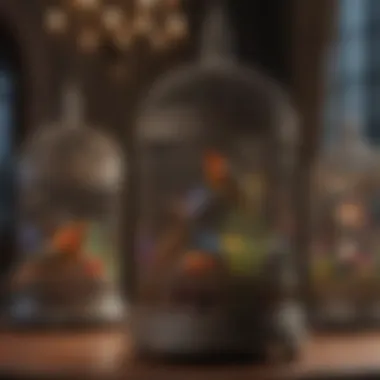
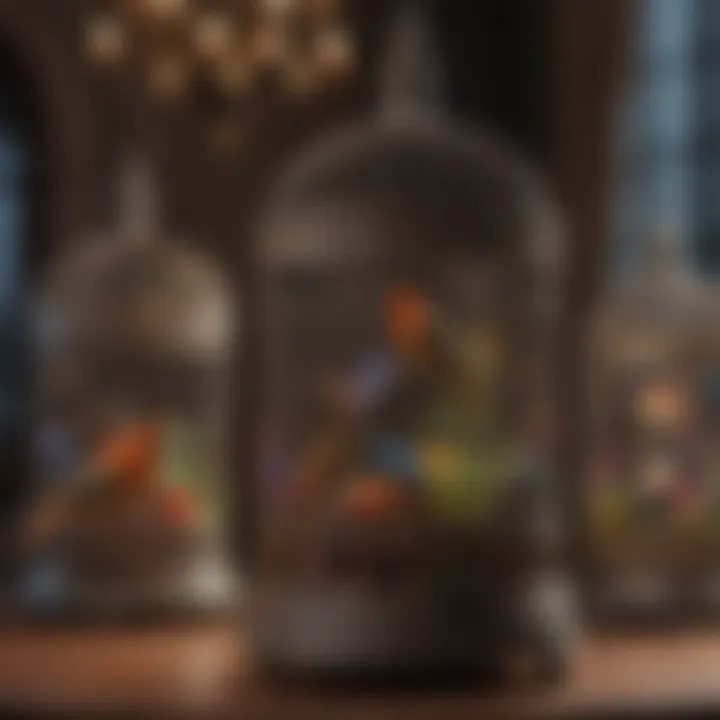
Intro
Decorative large bird cages serve as both functional habitats and aesthetic focal points in many homes. As avian companions display unique personalities and behaviors, the environment they inhabit plays a crucial role in their overall well-being. This article will explore various aspects of decorative bird cages, emphasizing the need for thoughtful design, appropriate care, and understanding of bird behavior. It aims to equip bird enthusiasts—whether pet owners, aspiring bird parents, or breeders—with insights that elevate the experience of cage keeping.
By looking into care tips, behavioral insights, nutrition guides, wellness checks, and enriching activities, this narrative will delve into what it means to create a nurturing environment for birds. A well-designed decorative cage not only enhances the beauty of one's living space but also contributes significantly to the happiness and health of birds.
Care Tips
Creating a nurturing environment for birds begins with proper care. Daily routines and maintenance are essential elements to ensure that the cage becomes a sanctuary for your feathered friends.
Daily Care Routines
Establishing a daily care routine is invaluable. This can involve feeding birds fresh pellets or seeds twice a day, ensuring access to clean water, and observing their behavior for any signs of distress. Additionally, changing food and water bowls daily reduces the risk of spoilage and contamination.
Cage Setup and Maintenance
Setting up the cage must consider the species of bird. Decorative cages should have enough space to move and play. Placement of perches, toys, and feeding stations should promote an active lifestyle. An ideal setup includes:
- Perches at varying heights
- Toys for stimulation
- Nest boxes for breeding birds
Regular maintenance involves checking the integrity of the cage and ensuring it remains safe.
Hygiene and Cleaning Practices
Cleanliness is non-negotiable in bird care. Cages should be cleaned weekly with bird-safe detergents. Droppings and food remnants should not remain for long periods. Here are some hygiene practices to consider:
- Remove waste every day
- Soak toys in warm water to clean them weekly
- Wash food and water dishes with soap and hot water
Seasonal Care Adjustments
As temperatures change, adjustments may be necessary. In the winter, ensure that cages are placed away from drafts, while in the summer, ensure proper ventilation. Covering cages during hot months can provide shade but ensure that birds still have adequate light.
Bird care is a blend of love and responsibility. When you prioritize their environment, their well-being can thrive without limit.
Behavioral Insights
Understanding bird behavior is essential to ensuring they feel comfortable and secure in their cages. This section examines how to interpret their actions and address their needs effectively.
Understanding Bird Body Language
Birds communicate primarily through body language. Certain actions, such as ruffled feathers or specific vocalizations, can indicate stress or contentment. Learning to read these signs can enhance both the care experience and the relationship with your birds.
Common Behavioral Issues and Solutions
Behavioral issues can manifest when birds feel neglected or stressed. Common problems include:
- Excessive screaming
- Feather plucking
- Aggression
By ensuring proper social interaction and enrichment, many of these issues can be alleviated.
Positive Reinforcement Techniques
Employing positive reinforcement can improve behavior. Providing treats or verbal praise when birds exhibit desirable behavior helps strengthen that behavior over time. Consistency is key in these interactions.
Social Interaction Needs
Birds are social creatures. They thrive on interaction, both with humans and other birds. Time spent outside their cages, even for short periods, greatly benefits their mental health.
Nutrition Guides
A balanced diet is crucial for the health and vitality of birds. This section outlines key components and strategies for feeding.
Essential Diet Components
Birds require a mix of seeds, pellets, fruits, and vegetables to maintain health. Each species may have specific needs. Researching the dietary requirements for particular breeds is vital.
Safe and Toxic Foods
Knowledge about safe and toxic foods can prevent emergencies. Many common foods like avocado, chocolate, and caffeine are harmful. Ensure your diet includes nutrient-rich choices while avoiding the dangerous ones.
Supplements and Treats
Occasional dietary supplements can promote health. For example, calcium supplements are beneficial for breeding birds. Treats like millet sprays may be given in moderation, as they provide enjoyment without compromising health.
Feeding Strategies for Different Species
Different species will have varied feeding preferences. Researching what specific birds eat and adjusting accordingly can lead to better health outcomes.
Wellness and Health
Routine health checks and being attentive to signs of illness are paramount. This section focuses on how to identify and maintain optimal health for your birds.
Routine Health Checkups
Regular vet visits should be scheduled, especially for new birds. Avian veterinarians can provide check-ups and vaccinations specific to birds.
Identifying Symptoms of Illness
Birds can conceal illnesses effectively. Key symptoms that may indicate a problem include lethargy, changes in droppings, and loss of appetite. Recognizing these early signs can be critical.
Preventative Care and Vaccinations
Preventive measures, such as vaccinations, can protect against diseases. Adhering to a vet's recommendations regarding vaccinations is essential for long-term health.
Mental and Emotional Well-being
Creating an enriching and stimulating environment helps maintain their emotional health. Activities that promote interaction and play affect their happiness significantly.
Enriching Activities
Providing engaging and stimulating activities for birds creates a vibrant atmosphere. This section offers ways to enhance their daily experiences.
Toys and Playtime Ideas
Selecting toys that cater to a bird’s physical and mental abilities can keep them occupied. Rotate different toys to maintain their interest and prevent boredom.
Training and Tricks
Training birds can deepen your bond and provide them a challenge. Simple commands like ‘step up’ can lead to more complex tricks over time.
Outdoor Activities and Interaction
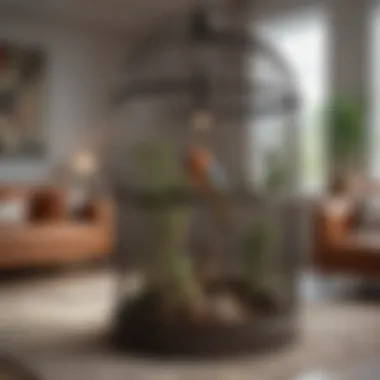
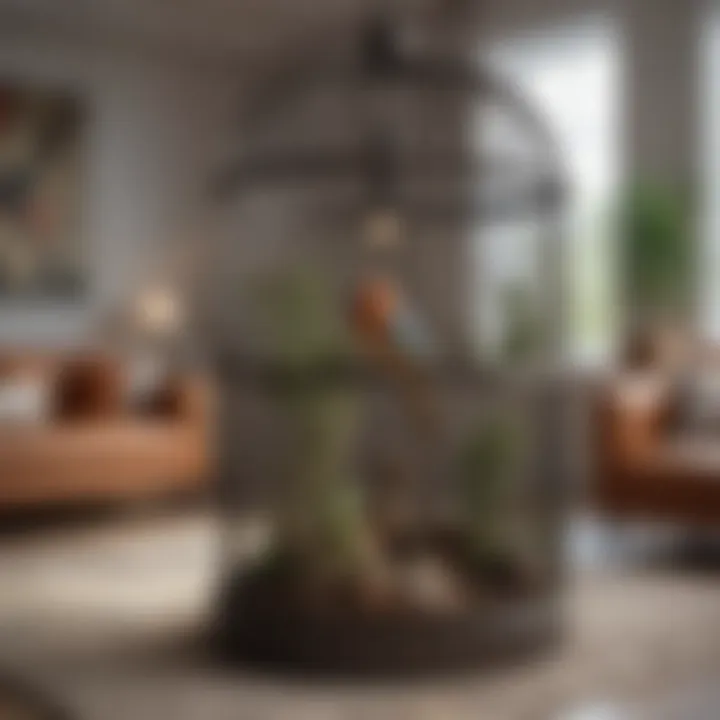
Outdoor time can stimulate birds immensely. Supervised outings give birds exposure to natural light and sounds, which are vital for their development.
DIY Projects for Mental Stimulation
Birds enjoy interactive crafts and projects. Simple DIY toys made from safe materials can enrich their environment and encourage mental engagement.
This comprehensive exploration into the world of decorative large bird cages underscores how critical it is to merge aesthetics with functionality. Optimizing the habitat not only benefits the bird but enhances the human experience as well.
Prologue to Decorative Large Bird Cages
Large bird cages serve a significant purpose in the lives of pet bird owners. These structures are not just housing solutions; they are a vital part of the overall well-being of the birds and offer a blend of aesthetic appeal and functionality. When choosing a bird cage, it is essential to consider various factors that affect both the birds and the owners.
First, decorative large bird cages provide ample space for birds to move, exercise, and establish their territories. Birds that are confined to small spaces may exhibit stress or behavioral issues. Adequate space allows for flying, climbing, and exploring, which are crucial for their physical and mental health.
Moreover, the design of the cage significantly influences its role in the home. Owners often seek cages that harmonize with their interior decor. This dual purpose enhances the home environment, making it visually pleasing while ensuring the comfort and happiness of the birds.
In addition, large decorative cages can be customized with accessories like perches, toys, and other enrichments to create a stimulating habitat. These features can improve the overall quality of life for the birds. It is important for owners to determine the right size, materials, and design elements that align with their specific bird species needs and personal style.
Ultimately, understanding decorative large bird cages is a blend of aesthetic choices and practical considerations. As this article unfolds, it will explore various aspects like historical context, design options, and health implications for the birds. By examining these elements, bird enthusiasts can make informed decisions and contribute to enhancing avian well-being in their homes.
Historical Context of Bird Cages
Understanding the historical context of bird cages sheds light on their evolution and significance in human culture. Bird keeping dates back thousands of years. It was not just about aesthetics, but also about companionship and status. Decorative large bird cages have emerged as an intersection of art, function, and cultural importance.
Evolution of Cage Designs
Historically, bird cages were crafted from materials available in local environments. Early models were simple wooden structures. Over time, they began to take on intricate designs, incorporating metals and glass. The Victorian era significantly influenced bird cage designs, marked by elaborate features and ornate decorations. The introduction of the wrought iron bird cage, for instance, demonstrated a blend of durability and beauty.
Today’s bird cages also reflect shifts in design priorities, with an emphasis on both visual appeal and practicality. Consumers look for cages that complement their interior décor while considering the well-being of their birds. Innovations in materials such as stainless steel and non-toxenic coatings have improved both safety and design versatility. This evolution highlights how decorative cages have moved from basic containers to sophisticated homes for birds.
Cultural Significance of Bird Keeping
Bird keeping has deep cultural roots across the globe. In various cultures, birds symbolize freedom, beauty, and companionship. Ancient Egyptians revered birds and often kept them in cages for decorative purposes, showcasing their importance in daily life. In Asia, particularly in China, keeping songbirds in beautiful cages has been a longstanding tradition, with competitions held to showcase birds’ vocal abilities.
In modern society, the cultural aspects have evolved. Bird ownership connects people to nature, provides emotional support, and fosters community among enthusiasts. Many bird keepers join associations or online forums, such as subreddit communities on Reddit, where they share experiences and knowledge.
"Birds remind us of the beauty of nature and the possibility of connection. They bring joy to our lives and serve as companions in our homes."
This cultural backdrop is essential for understanding contemporary decorative bird cages and the values modern bird owners place on both form and function. Individuals are not just seeking a cage; they aim to create a nurturing environment that honors their birds’ natural behaviors and enhances their own living spaces.
Understanding Large Bird Cages
Understanding large bird cages is fundamental for any bird owner keen on providing the best habitat for their avian companions. These cages represent more than just a space for birds. They are important for both the physical and psychological well-being of the birds. Choosing the right cage encompasses various considerations that impact birds' health and happiness.
Definition and Dimensions
Large bird cages are defined by their considerable size, which accommodates various bird species that require ample space to move freely. The dimensions of a large bird cage can vary widely, typically starting from two feet in width and four feet in height. For larger species such as macaws or cockatoos, dimensions can extend up to six feet or more in height and width.
When selecting a cage, it is crucial to consider not just the overall size, but also the interior space. Birds need room to stretch their wings fully without restrictions. Measurements should also account for areas necessary for perches, toys, and food dishes.
Materials Used in Construction
The construction materials of large bird cages directly influence durability and safety. Common materials include stainless steel, powder-coated metal, and wood.
- Stainless Steel: This material is known for its strength and resistance to rust and corrosion. It is a preferred choice for many bird owners who seek longevity in a cage.
- Powder-coated Metal: A more economical option that offers a variety of colors. However, it is essential to ensure that the coating is non-toxic and safe for pets.
- Wood: Some cages incorporate natural wood elements, giving a more aesthetic appeal but may require more maintenance to ensure they remain clean and free from toxins.
Aesthetic Appeal of Decorative Cages
The aesthetic appeal of decorative large bird cages extends beyond mere visual attraction. It encapsulates the essence of personal expression and the way it integrates into one's living environment. An appealing cage can enhance the beauty of a space and serve as a functional yet stylish element in home décor. For bird owners, this aspect becomes more than just an embellishment; it signifies a commitment to the well-being of their feathered companions while reflecting their personal taste.
The design and construction of a large bird cage should harmonize with the aesthetics of the home. These cages often become focal points in rooms, prompting owners to consider not just the birds’ needs but also how the cage complements the overall ambiance. This dual purpose emphasizes the balance between art and utility, ensuring that owners can showcase their pets without compromising their home’s visual integrity.
Some important considerations of aesthetic appeal include:
- Material Selection: The choice of materials, like wrought iron or bamboo, contributes greatly to the visual impact and durability of the cage.
- Color Schemes: Cages can feature a variety of colors that either stand out or blend seamlessly with other décor elements.
- Size and Shape: The dimensions and form of the cage can influence how it is perceived in a room. Larger, more ornate cages often command attention, while simpler designs can offer subtle elegance.
"A beautifully designed cage not only enriches the bird's life but also enhances the space it inhabits"
Design Varieties and Trends
In recent years, design varieties in decorative large bird cages have become increasingly diverse. This variety allows for customization in terms of style, function, and even bird species suitability. Some popular trends include industrial, minimalist, and vintage styles, each offering unique visual flavors and practicalities.
- Industrial Design: Characterized by a robust frame and sometimes accompanied by metallic finishes. It appeals to modern aesthetics while providing durability.
- Minimalist Cages: Simple designs with clean lines that focus on functionality. They emphasize open space and a natural look, often made from materials like acrylic or powder-coated metals.
- Vintage Styles: These cages often feature intricate detailing and ornate designs, reminiscent of earlier times. They can add a charming historical feel to any room.
These trends not only cater to aesthetics but also consider the changing needs of both birds and their owners.
Integration into Home écor
The integration of large decorative bird cages into home décor is crucial for creating a cohesive living environment. This process involves thoughtful arrangement and selection of cages that resonate with the overall design of a home.
Cages can be positioned in various ways to enhance their visual impact:
- Corner Display: Utilizing corner spaces can create an inviting nook that draws attention.
- Central Focal Point: Placing a large, beautifully designed cage in a living room or hallway can serve as a conversation starter.
- Gallery Style: Incorporating multiple cages amidst framed art or plant displays can present a visually appealing and lively atmosphere.
When selecting a cage, consider how it aligns with existing décor elements, such as color palettes, furniture styles, and other decorative items. The goal is to forge a sense of harmony that allows the bird cage to shine as part of the interior design, catering to both aesthetic desires and practical needs.
Functional Aspects of Large Bird Cages
Understanding the functional aspects of large bird cages is essential for both the welfare of the birds and the satisfaction of their owners. Large bird cages are not merely decorative; they serve vital purposes that ensure the health and happiness of the birds they house. This section explores the key elements of comfort, space, accessibility, and maintenance, highlighting their importance in achieving a harmonious balance between form and function.
Comfort and Space for Birds
Comfort is paramount for birds kept in captivity. Large bird cages should provide adequate space for movement and behaviors that mimic their natural habitats. Birds are active creatures; they need room to fly, climb, and explore. An appropriate cage design considers the species-specific behaviors and characteristics.
A good practice is to select a cage that is at least twice the wingspan of the bird when fully extended. For instance, a cockatoo may benefit from a cage that measures 36 inches or more in width and height. Different birds have different needs, so it is imperative to tailor the choice of cage accordingly.
Key considerations for comfort include:
- Bar spacing: Bars should be spaced correctly to prevent escape and injury.
- Perches: Varied perch locations and materials facilitate natural movements.
- Enrichment: Incorporating toys and puzzles helps keep birds mentally stimulated.
Ultimately, choosing a spacious and appropriately equipped cage allows for a healthier and more satisfying environment for pet birds.
Accessibility and Maintenance Considerations
Welcoming environments also require practical maintenance routines. Accessibility is critical for caregivers to efficiently attend to the birds’ needs. A well-designed large bird cage allows easy access to all areas, ensuring that cleaning, feeding, and overall health checks are manageable tasks.
When selecting or designing a large bird cage, features that enhance accessibility can include:
- Removable trays: Trays simplify cleaning and help contain messes.
- Wide doors: Large openings allow for easy feeding and interaction with the birds.
- Cage layout: Consideration should be given to the arrangement of objects within the cage to enable effortless reach.
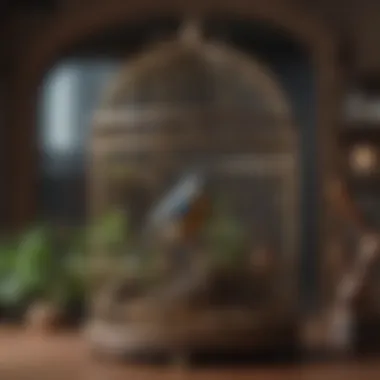
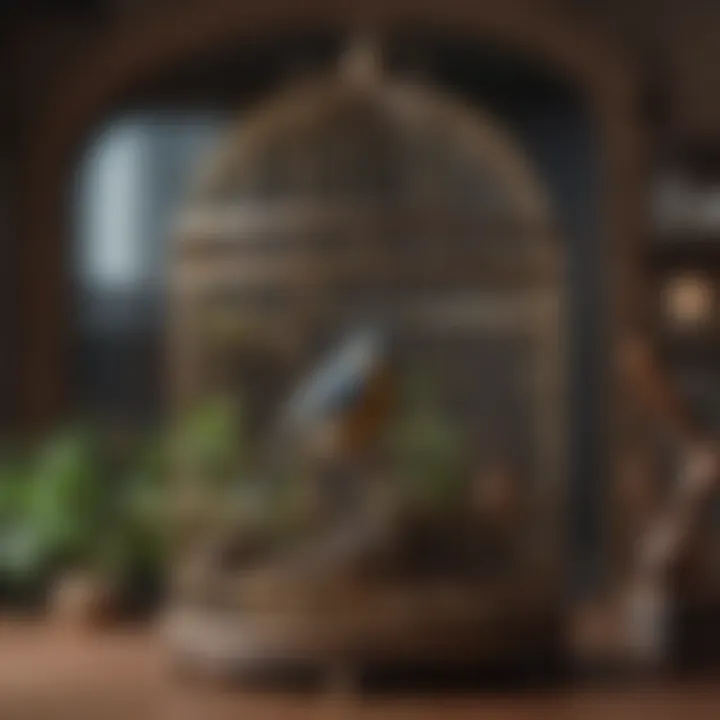
Cleaning protocols must be established based on the materials used and the bird's lifestyle. Regular cleaning prevents health issues related to droppings and mold growth. A weekly cleaning routine, for example, is often sufficient, but high-traffic areas may need more frequent attention.
A supportive environment not only enhances the quality of life for birds, but also fosters a positive experience for their human caregivers. Ensuring proper comfort and maintenance is essential in promoting bird health and happiness.
Choosing the Right Cage for Your Bird
Choosing the right cage for your bird is a critical aspect of responsible bird ownership. The cage is not just a physical structure but a habitat where the bird will spend a significant amount of its life. Thus, it assumes a great importance in ensuring the overall well-being and happiness of your feathered companion. Factors such as species, size, and configuration of the cage must be carefully considered. When selecting a cage, it is essential to reflect on both the functional needs of the bird and the aesthetic preferences of the owner.
In this section, we will explore key elements involved in making informed choices about bird cages. From an understanding of specific species requirements to the evaluation of size and configuration, these considerations will help ensure that your bird has a safe, comfortable, and stimulating environment.
Species-Specific Requirements
Different bird species have distinct needs that must be addressed when selecting a cage. For example, a parrot may require a larger cage with sturdy bars due to their size and strength, whereas smaller bird species, like finches, may do well in a more compact design. Moreover, some birds are naturally more active and require additional space for hopping, flying, and climbing.
Some factors to consider include:
- Bar Spacing: The distance between bars is crucial. Too wide, and smaller birds can escape or get stuck; too narrow, and larger birds may feel cramped.
- Cage Height vs. Width: Some birds, such as canaries, prefer height, while others, like budgerigars, enjoy width for flying.
- Accessories and Perches: Different species benefit from different accessories. Providing suitable perches, toys, and other enrichment items should align with your bird's natural behavior.
"Every bird species is unique, and understanding these variations can drastically improve their quality of life in captivity."
Evaluating Cage Size and Configuration
Once you identify the species-specific requirements, the next step is evaluating cage size and configuration. A cage that is too small can lead to stress and health issues, so ensuring adequate space is crucial.
Important considerations include:
- Cage Dimensions: Aim for the largest cage possible within your chosen location. The dimensions should allow your bird to spread its wings comfortably without touching the bars.
- Configuration: Look for a cage that provides vertical and horizontal space. This includes multiple levels, ledges, and plenty of perches. A multi-tiered cage can encourage climbing, which is beneficial for the bird’s physical health.
- Accessibility: Ensure that the cage door opens wide and is designed for easy access to allow for both human interaction and maintenance tasks.
In summary, when choosing a cage for your bird, remember that every decision you make affects their wellbeing. Focus on individual species needs and the right dimensions to create a thriving environment.
Decorative Accessories for Bird Cages
Decorative accessories play a crucial role in enhancing the living environment of birds within large decorative cages. They are not just about aesthetics; these elements contribute significantly to the well-being of avian occupants. By carefully selecting accessories, one can create a habitat that balances beauty with functionality.
When considering accessories, think about the needs of the birds. Comfort and stimulation are essential for maintaining their physical and mental health. Additionally, the right accessories can transform the cage into a vibrant part of your home decor. A thoughtful combination of design and practicality elevates the living space for both birds and their owners.
Flooring and Perches
Flooring in bird cages should not be overlooked. The choice of flooring influences not only the visual appeal of the cage but also the comfort of the birds. Common options include grated floors that promote cleanliness and solid wood or synthetic materials that provide better footing. Each material has its benefits:
- Grated Flooring: Offers easy drainage and prevents debris buildup, but can be harsh on bird feet.
- Solid Flooring: Typically more comfortable for birds. However, it requires more maintenance as waste can accumulate more easily.
Ensure that the flooring is easy to clean while promoting a safe and comfortable environment. Perches are equally important. The placement, size, and material of perches can affect your bird's foot health and overall comfort.
Birds benefit from perches made of varied materials and diameters. This variation allows them to exercise their feet, which is essential for their health. Natural wood perches offer a more natural feel, while covered perches add traction. Consider providing multiple perches at different heights to encourage movement and exploration within the cage.
Toys and Enrichment Items
Toys and enrichment items should be an essential part of any bird's cage. Birds are naturally curious and intelligent creatures that require stimulation to prevent boredom and promote mental health. Popular types of toys include:
- Chewing Toys: Made from safe woods or cardboard, these help keep their beaks healthy.
- Climbing Structures: Provide opportunities for exercise and exploration.
- Interactive Toys: Require birds to solve puzzles or perform actions to receive treats, which encourages mental engagement.
Regularly rotate toys to maintain interest and also check for wear and tear. Replacing worn toys is vital to ensure the safety and enjoyment of your birds.
In such an environment filled with engaging accessories, birds not only thrive but the overall aesthetic of the cage is enhanced. It is clear that selecting the right decorative accessories requires thoughtful consideration, balancing beauty, functionality, and the specific needs of your feathered friends.
Care and Maintenance of Large Bird Cages
Caring for and maintaining large bird cages is essential for the overall well-being of your avian companions. Regular attention to these cages ensures not only the hygiene and aesthetic qualities but also the health and happiness of the birds living in them. The following sections provide key insights into effective cleaning protocols and strategies to prevent wear and tear, both of which are vital components of responsible bird ownership.
Cleaning Protocols and Frequency
Maintaining cleanliness in a bird cage directly impacts the health of the birds. It involves not just frequent surface cleaning but also a deep clean to address areas that may harbor bacteria or parasites. Here are several important guidelines for cleaning:
- Daily Spot Cleaning: Every day, remove any uneaten food, droppings, and debris from the perches and cage floor. This habit reduces odors and prevents the build-up of harmful pathogens.
- Weekly Deep Cleaning: Once a week, conduct a thorough cleaning. This includes disassembling removable parts like trays and perches, washing them in hot soapy water, and rinsing well. Avoid using harsh chemicals that can harm birds.
- Monthly Disinfection: Every month, on top of regular cleaning, consider using a bird-safe disinfectant to eliminate remaining bacteria and germs. Ensure the cage is completely dry before placing the birds back inside.
- Seasonal Maintenance: At least every season, check all components of the cage for wear and tear and clean the outside of the cage thoroughly.
Following a structured cleaning schedule helps maintain a healthy environment for the birds, minimizing the risk of diseases.
Preventing and Addressing Wear and Tear
Large bird cages are an investment and require proper care to extend their lifespan. Here are key points to consider:
- Material Inspection: Regularly inspect the materials of the cage for signs of wear. Look for rust, corrosion, or other damage, especially if the cage is made of metal. Wooden cages should be checked for splinters or rotting.
- Replacement Parts: Keep an eye on perches, toys, and other accessories. These should be replaced as they show signs of wear. Worn items can pose a risk to the birds and affect their comfort and safety.
- Location Considerations: Place the cage in a suitable location that avoids direct sunlight for prolonged periods, which can degrade materials over time. The humidity and temperature of the environment can also affect cage longevity.
- Lock Integrity: Regularly check that locks and latches are operational. A damaged lock poses a significant safety risk, allowing birds to escape or enabling predators access.
By proactively caring for the cage, you help prevent more significant issues and assure a safe space for your birds. Taking such steps not only prolongs the life of the cage but also enhances the overall comfort and safety of your beloved pets.
Health Implications for Birds in Decorative Cages
Understanding health implications for birds in decorative cages is important for any bird owner. Birds are not just pets; they are sensitive creatures requiring specific care for their well-being. When considering decorative large bird cages, one must focus on both the aesthetic value and the health of the birds inhabiting these spaces. Proper design and functionality can greatly impact a bird's mental and physical health, which in turn affects their overall happiness and longevity.
Mental Stimulation and Behavioral Health
Mental stimulation is essential for birds. They are intelligent animals possessing a strong need for interaction and engagement. Decorative cages should include features that encourage exploration and play. Incorporating various levels, perches, and toys can prevent boredom. Here are some practical ideas:
- Variety of Perches: Use different sizes and materials for perches. Birds enjoy changing their location and experiencing varying textures.
- Interactive Toys: Include toys that can be turned, pulled, or solved. This keeps the bird engaged and challenges their problem-solving skills.
- Natural Elements: Use branches or natural wood perches to mimic their natural habitat. This not only adds aesthetic value but also provides mental encouragement by simulating the outdoors.
Promoting mental health also involves understanding behavioral cues. Signs of stress or boredom can include excessive screaming, feather plucking, or even aggression. Addressing these behaviors promptly is necessary to maintain a happy environment for your bird.
Physical Space and Movement
Physical space is another crucial aspect of a bird's health. Large bird cages are naturally designed to provide ample room, but it's essential to assess if the space is utilized effectively. Birds require enough room to stretch, move, and fly appropriately. Here are considerations for optimizing physical space:
- Dimensions Matter: Ensure the cage height and width align with the species' flying capabilities. For example, larger species such as Macaws need tall cages to fly up and down comfortably.
- Configuration: Select a cage design that allows for both horizontal and vertical movement. Birds should feel encouraged to move freely while engaging with their environment.
- Exercise Areas: Consider adding a safe play area outside the cage. Birds often benefit from the chance to fly or play outside of their enclosure, enhancing their physical fitness.
Innovation in Bird Cages
In recent years, the realm of decorative large bird cages has seen significant innovations, blending functionality with aesthetic appeal. These advancements are particularly noteworthy as they cater to the evolving needs of both bird owners and their avian companions. This section will delve into two primary areas of innovation: smart cages and the use of sustainable materials, both of which offer substantial benefits to the practice of bird keeping.
Smart Cages and Technology Integration
Smart cages are a pioneering innovation in bird care that integrates modern technology with traditional cage design. These cages are equipped with various features aimed at enhancing the living conditions of the birds inside. For example, many smart cages offer climate control systems to maintain optimal temperature and humidity levels, ensuring the well-being of the inhabitants. Furthermore, some designs include feeding and watering systems that can be programmed for automatic dispensing. This reduces the need for constant human intervention, thus allowing owners more freedom without sacrificing their birds' needs.
Moreover, smart cages often come with monitoring systems that track the health and behavior of the birds. These features enable owners to receive real-time updates on their pets' activity levels, which is crucial for identifying any health issues early. The integration of mobile apps allows owners to interact with their birds remotely, adding another layer of engagement.
In summary, smart cages do not only enhance the aesthetic value of a home but also underscore a commitment to the welfare of the birds housed within. The technology implemented in these cages empowers owners to maintain a high standard of care while enjoying the decorative aspect of the cages.
Sustainable Materials and Practices
Sustainability is an essential consideration when it comes to the production and use of decorative bird cages. The growing environmental concerns prompt manufacturers and consumers alike to look for eco-friendly alternatives. It is vital to ensure that the materials used in large bird cages do not only contribute to the visual appeal but also promote ecological responsibility.
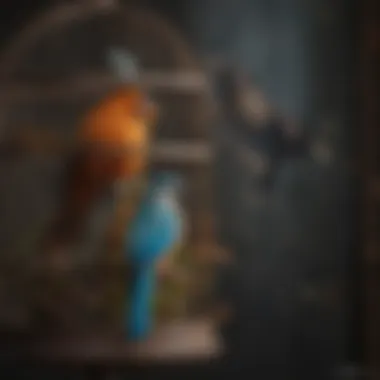

Cages constructed from sustainably sourced wood, like bamboo or reclaimed wood, are becoming increasingly popular. These materials do not only meet aesthetic desires but also reduce the environmental impact associated with deforestation. Likewise, non-toxic paints and finishes are critical for maintaining the safety and health of birds. Many manufacturers now prioritize the use of biodegradable or recyclable materials, which contribute to reducing waste in the long run.
Additionally, production processes that minimize energy consumption and utilize renewable energy sources are gaining traction. This transition is essential for promoting a sustainable future in avian care. By choosing products made from sustainable materials and employing eco-friendly practices, bird owners can play a part in protecting the environment while providing their pets with a beautiful and safe home.
The Role of Community in Bird Keeping
The role of community in bird keeping serves as a foundational element in shaping the experiences of bird owners. Engaging with fellow bird enthusiasts provides support, knowledge, and a sense of belonging. The community plays a critical role in fostering best practices, sharing valuable information, and helping new bird owners navigate challenges. Understanding these aspects can greatly enhance both the enjoyment and welfare of the birds kept within decorative large cages.
Support Networks for Bird Owners
Support networks are essential for anyone involved in bird keeping. Such networks often include local clubs, online forums, and social media groups. These platforms create opportunities for bird owners to connect with others who share similar interests. Through personal stories, pet bird owners can gain insights and advice that are not easily found in books or articles. Things like proper care tips, breeding practices, and health considerations can be exchanged in these forums.
In many communities, organized events take place. These might be bird shows, care workshops, or breed meetings. Attending such events offers valuable chances to learn and network. Here are some examples of how these support networks benefit bird owners:
- Access to Expertise: Many seasoned breeders and bird owners share their knowledge freely. Their experiences can help others avoid common pitfalls.
- Resource Sharing: Information about local veterinarians, suppliers, and breed-specific clubs helps members find what they need.
- Networking Opportunities: Members can foster friendships and form bonds over shared passions.
Sharing Resources and Best Practices
Sharing resources and best practices is a vital function of the bird keeping community. This involves more than simply passing along tips; it is about creating a culture of knowledge and collaboration. The information shared among members is practical, ranging from care and feeding to cage setup. Following established best practices greatly enhances the comfort and well-being of pet birds.
Bird owners can exchange various resources including:
- Care Guidelines: Written guidelines that cover everything from feeding schedules to health monitoring.
- Local Resources: .specific contacts for avian vets, pet stores, or suppliers of food and decor.
- Educational Materials: Articles, videos, and books that members recommend can illuminate different aspects of bird care.
When best practices are shared openly, new owners feel supported, leading to a healthier environment for birds. This, in turn, ensures that decorative cages serve their purpose as both living spaces and aesthetic additions to homes. As owners implement these shared practices, they contribute to building a knowledgeable community and fostering the welfare of their birds.
"A strong community empowers bird owners, creating a better environment for both birds and their keepers."
Designing a Flight-Friendly Environment
Creating a flight-friendly environment within decorative large bird cages is essential for the well-being of pet birds. Birds are naturally inclined to fly and explore their surroundings. Therefore, it is crucial to design their habitats in a way that encourages movement and activity. This section underscores the importance of incorporating natural elements and creating safe, stimulating spaces that uphold avian happiness and health.
Incorporating Natural Elements
Integrating natural elements into a bird cage design can significantly enhance the living conditions for birds. Utilizing branches, silk plants, and natural wood perches gives a more organic feel to the environment. Such materials not only mimic their natural habitats but also provide opportunities for climbing and exploring.
Birds benefit from the textures and varying shapes that these natural elements offer. For instance, real tree branches can aid in maintaining claw health and provide opportunities for chewing. Moreover, having live plants can improve air quality but requires careful selection to ensure that the plants chosen are non-toxic to birds. In addition to visual appeal, these elements serve functional purposes, creating a richer environment for the birds.
- Materials to Consider:
- Untreated branches from non-toxic trees, like willow or birch
- Natural wooden perches of varied thicknesses
- Silk or plastic plants that are safe for birds
Incorporating natural elements encourages birds to engage in instinctual behaviors, promoting physical health and mental stimulation. This can lead to a happier, more vibrant pet bird.
Creating Safe and Stimulating Spaces
A safe environment is paramount for any pet bird. The layout of the cage should avoid hazards like sharp edges or small items that could be swallowed. Placing objects in a way that provides ample safe perching spots and hiding places can help birds feel secure while still allowing for easy movement.
- Key Points for Safety:
- Ensure all materials are non-toxic
- Avoid using toxic paints or finishes that birds might ingest
- Regularly check for any wear or damage to toys and perches
Stimulation is also critical in this context. Birds thrive on engagement, so including a variety of toys that encourage foraging, swinging, and climbing can enhance their quality of life. This could include edible toys or puzzles designed specifically for birds. Having these elements prompts exploration and activity, aligning with their natural behaviors.
"A well-designed cage promotes not just safety, but also mental enrichment for birds."
Furthermore, arranging toys and climbing structures at different heights encourages birds to venture throughout the cage. This vertical space increases their ability to exercise, which is vital for their overall health.
By thoughtfully designing a flight-friendly environment with appropriate natural elements and stimulating features, bird owners can create a nurturing and enjoyable habitat for their avian companions.
Market Trends in Decorative Bird Cages
The market for decorative large bird cages has evolved significantly, influenced by changes in consumer preferences and design innovations. Understanding these trends is crucial for both bird enthusiasts and manufacturers. This section explores the latest influences and demands on the market, emphasizing the importance of aesthetics, functionality, and environmental consciousness.
Consumer Insights and Preferences
Recent studies show that consumers are increasingly looking for bird cages that not only prioritize the comfort and health of their pets but also reflect personal style. Aesthetic appeal is a major consideration, with many owners seeking cages that integrate well with their home décor.
Key consumer preferences include:
- Customization Options: Many buyers appreciate the ability to personalize their cages with colors, materials, and additional accessories. This trend allows owners to create a unique environment that stands out in their living space.
- Sustainability: There is a growing awareness about the environmental impact of products. Bird owners prefer cages made from sustainable materials that do not compromise on durability or safety.
- Space Efficiency: The trend towards minimalist living has also affected bird cage designs. Many consumers favor large cages that maximize vertical space while being compact enough for smaller homes.
This focus on personalization, sustainability, and space efficiency indicates a shift in how consumers view decorative bird cages— not merely as functional items but as integral parts of their home life.
Emerging Brands and Innovations
The competitive landscape for decorative bird cages is shifting as new brands enter the market with innovative solutions to meet consumer demands. Established brands are also adapting, refreshing their designs and incorporating modern technologies.
- Technological Integration: Some brands now incorporate smart technology into their cages. These innovations may include temperature control, lighting options, and monitoring systems that help owners keep track of their bird’s health and activity levels.
- Innovative Materials: Brands are exploring advanced materials, such as recycled plastics and metals, providing eco-friendly options that do not sacrifice quality or safety. These innovations resonate with the environmental consciousness of modern consumers.
- Design Collaborations: Collaborations between bird cage manufacturers and designers have led to unique, artistic cages that appeal to a more design-savvy market. These cages are often seen as statement pieces, appealing to consumers with an aesthetic focus.
The evolution of the market for decorative bird cages reflects broader trends in consumer behavior towards sustainability, customization, and integration of technology.
Overall, the market trends in decorative large bird cages illustrate a dynamic interplay between consumer desires and manufacturer responses. As pet ownership continues to grow, understanding these trends becomes increasingly important for anyone involved in bird keeping. The future looks promising, with more innovations aimed at enhancing the life quality for both birds and their owners.
Environmental Impact of Bird Cages
Bird cages, particularly decorative large ones, play a role beyond mere aesthetics. Their environmental impact is significant and warrants careful consideration by bird owners and enthusiasts. This section discusses various aspects of how bird cages affect the environment and emphasizes responsible ownership.
Resource Use and Conservation
When selecting a bird cage, it is crucial to consider the materials used in its construction. Many traditional cages are made from metal or wood, sourced from unsustainable practices. For example, cages made from hardwoods may contribute to deforestation. As consumers, it is our responsibility to choose products that prioritize sustainable practices.
To reduce environmental footprint, look for bird cages constructed from recycled materials or sourced from sustainable environments. Companies that certify their wood products can provide peace of mind regarding responsible sourcing.
Additionally, conservation must extend to the production process. Manufacturing bird cages often involves energy consumption and waste generation. Opting for local artisans or brands reduces transportation emissions, which is another way to consider the ecological implications of your choice.
Promoting Eco-Friendly Practices
Promoting eco-friendliness in bird cage selection and maintenance can positively impact the planet. Here are several best practices that can help:
- Choose Non-Toxic Treatments: Ensure that any finishes, paints, or treatments applied to the cage meet safety standards for pets and do not release harmful chemicals into the environment.
- Maintain Regularly: Keeping the cage clean reduces the need for replacements. Proper cleaning protocols can enhance durability and lessen waste.
- Recycling Old Cages: When it's time to replace an old cage, consider recycling. Many metals can be reused, and some communities have programs for recycling pet products.
- Incorporate Plants: Using natural elements such as live plants within or around the cage can provide a habitat-friendly environment. Make sure to choose non-toxic plants safe for birds.
"Sustainable practices not only benefit the environment; they enrich the lives of our pets by creating healthier spaces!"
Culmination
In concluding this exploration of decorative large bird cages, it is vital to highlight the multi-dimensional aspects that make them not only significant but also beneficial to both birds and their owners. Decorative large bird cages are more than mere structures for confinement; they serve as dynamic environments that cater to the psychological and physical needs of avian companions. Properly selected and designed, they offer comfort, security, and an engaging space that greatly influences the well-being of birds.
When choosing a cage, considerations such as species-specific requirements and appropriate dimensions are paramount. Each bird species has unique needs, and understanding these can lead to informed decisions that promote healthier lives for the birds. This perspective fosters a deeper appreciation for animal husbandry, transforming the relationship between pet and owner.
The integration of aesthetics, such as design variety and decorative accessories, cannot be overlooked. A well-designed cage enhances not only the living space of the bird but also the overall decor of a home. This dual function of being ornamental while serving a practical purpose is a cornerstone of modern pet ownership, encouraging owners to view their birds as integral members of the family.
Moreover, the ongoing advancements in technology and eco-friendly practices signify a shift towards more sustainable bird-keeping. Owners now have access to options that minimize environmental impact while innovating in their approach to care and maintenance.
As we reflect on the content provided throughout the article, it is clear that understanding the nuances of decorative large bird cages contributes to a richer experience for both the owner and their pet. This knowledge should inspire current and aspiring bird parents to create environments that prioritize avian welfare and foster a strong connection between humans and their feathered friends. In essence, decorative large bird cages represent a blend of beauty, functionality, and responsibility, underscoring the importance of thoughtful bird keeping in every home.















